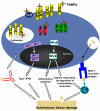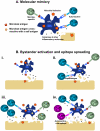Antiviral immune responses: triggers of or triggered by autoimmunity?
- PMID: 19319143
- PMCID: PMC2854652
- DOI: 10.1038/nri2527
Antiviral immune responses: triggers of or triggered by autoimmunity?
Abstract
The predisposition of individuals to several common autoimmune diseases, such as rheumatoid arthritis, systemic lupus erythematosus and multiple sclerosis, is genetically linked to certain human MHC class II molecules and other immune modulators. However, genetic predisposition is only one risk factor for the development of these diseases, and low concordance rates in monozygotic twins, as well as the geographical distribution of disease risk, suggest the involvement of environmental factors in the development of these diseases. Among these environmental factors, infections have been implicated in the onset and/or promotion of autoimmunity. In this Review, we outline the mechanisms by which viral infection can trigger autoimmune disease and describe the pathways by which infection and immune control of infectious disease might be dysregulated during autoimmunity.
Figures





References
-
- Ishii KJ, Koyama S, Nakagawa A, Coban C, Akira S. Host innate immune receptors and beyond: making sense of microbial infections. Cell Host Microbe. 2008;3:352–63. - PubMed
-
-
Fujinami RS, Oldstone MB. Amino acid homology between the encephalitogenic site of myelin basic protein and virus: mechanism for autoimmunity. Science. 1985;230:1043–5. This publication introduced the concept of molecular mimicry.
-
Publication types
MeSH terms
Substances
Grants and funding
LinkOut - more resources
Full Text Sources
Other Literature Sources
Medical
Research Materials

